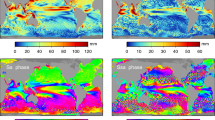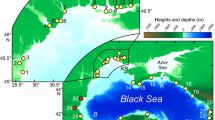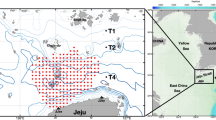Summary
Current data obtained from 7 moorings in the Northeast Atlantic in the course of many years are analysed with respect to semi-diurnal barotropic and baroclinic tides and diurnal barotropic tides. For semi-diurnal tides M2 and S2 the energy distribution is usually dominated by the barotropic mode; only in a few cases does the first-order baroclinic mode contain higher energy. Barotropic tidal ellipse orientations are found to be consistent with results from earlier tide gauge observations in this area. Significant deviations occur, however, in amplitudes. Results for the diurnal component K1 are also presented. With few exceptions, tides are found to be progressive waves in this area. The current ellipse pattern is similar to results obtained indirectly by Cartwright, Edden, Spencer et al. [1980] from tide gauge observations.
Zusammenfassung
Strömungsdaten von 7 Verankerungen, die im nordöstlichen Atlantik über mehrere Jahre ausgelegt waren, wurden im Hinblick auf halbtägige barotrope und barokline sowie eintägige barotrope Gezeiten analysiert. Bei den halbtägigen Tiden M2 und S2 dominiert normalerweise die Energie der barotropen Eigenfunktion, nur in wenigen Fällen enthält die barokline Welle 1. Ordnung höhere Energie. Die Ellipsenorientierungen für die barotropen Komponenten entsprechen früheren Ergebnissen von Tiefseepegeln in diesem Gebiet. Es gibt jedoch signifikante Abweichungen bei den Amplituden. Die Gezeiten in diesem Gebiet sind fast ausschließlich fortschreitende Wellen, in einigen wenigen Fällen jedoch vom gemischten Typ. Die räumliche Änderung der Strömungsellipsen entspricht weitgehend den Ergebnissen, die Cartwright, Edden, Spencer et al. [1980] indirekt aus Pegelbeobachtungen erhielten.
Résumé
Les mesures de courants provenant de 7 mouillages sur plusieurs années en Atlantique Nord-Est ont été analysées en ce qui concerne les marées semi-diurnes barotropes et baroclines et les marées diurnes barotropes. Pour les marées semi-diurnes M2 et S2 la répartition de l'énergie est généralement dominée par le mode barotrope; dans peu de cas seulement, le mode barocline de premier ordre renferme la plus haute énergie. Les orientations de l'ellipse relevant de la marée barotrope sont en accord avec les résultats d'observations marégraphiques antérieures dans cette région. Des écarts significatifs apparaissent toutefois en amplitude. Les résultats concernant la composante Ki sont également présentés. A quelques exceptions près, les marées, dans cette région, se sont trouvées être des ondes progressives. Le type d'ellipse des courants est semblable aux résultats obtenus indirectement par Cartwright, Edden, Spencer et al. [1980] à partir des observations marégraphiques.
Similar content being viewed by others
References
Accad, Y. and C. L. Pekeris, 1978: Solution of the tidal equations for the M2 and S2 tides in the World Oceans from a knowledge of the tidal potential alone. Philos. Trans. Roy. Soc. (A)290, 235–266.
Baker, D. J., 1981: Ocean instruments and experiment design. In: Warren, B. A. and C. Wunsch (eds.), Evolution of physical oceanography. Cambridge, Mass.: MIT Pr. pp. 396–433.
Cartwright, D. E., A. C. Edden, R. Spencer et al., 1980: The tides of the Northeast Atlantic Ocean. Philos. Trans. Roy. Soc. (A)298, 87–139.
Dickson, R. R., 1983: Global summaries and intercomparisons: Flow statistics from longterm current meter moorings. In: Robinson, A. R.: Eddies in marine science. Berlin [usw.]: Springer, pp. 278–353.
Doodson, A. T., 1941: Admiralty manual of tides. London: His Majesty's Stationary Office.
Fofonoff, N. P., 1966: Oscillation modes of a deep-sea mooring. Geo-mar. Technol.2, 13–17.
Godin, G., 1972: The analysis of tides. Liverpool: Liverpool University Press. 264 pp.
Gould, W. J. and W. D. McKee, 1973: Vertical structure of semi-diurnal tidal currents in the Bay of Biscay. Nature.244, No. 5411, 88–91.
Hendershott, M. C., 1977: Numerical models of ocean tides. In: Goldberg, E. D., I. N. McCave, J. J. O'Brien et al. (eds.), Th sea. Vol. 6: Marine modeling. New York: Wiley. pp. 47–95.
Hendershott, M. C., 1981: Long waves and ocean tides. In: Warren, B. A. and C. Wunsch (eds.): Evolution of physical oceanography. Cambridge, Mass. MIT Pr. pp. 292–341.
Krauss, W., 1966: Methoden und Ergebnisse der theoretischen Ozeanographie. Band 2: Interne Wellen. Stuttgart: Borntraeger. 248 pp.
Meincke, J., G. Siedler and W. Zenk, 1975: Some current observations near the continental slope off Portugal. “Meteor” Forsch.-Ergebn. (A) No. 16, 15–22.
Müller, T. J., 1981: Current and temperature measurements in the North-East Atlantic during NEADS. Ber. Inst. Meeresk. Kiel. No. 90, 100 pp.
Müller, T. J. and W. Zenk, 1983: Some Eulerian current measurements and XBT-stations from the North East Atlantic, October 1980—March 1982—A data report. Ber. Inst. Meeresk. Kiel. No. 114, 145 pp.
Munk, W. H. and D. E. Cartwirght, 1966: Tidal spectroscopy and prediction. Philos. Trans.Roy. Soc. (A)259, 533–581.
Price, J. M., 1983: Historic hydrographic and meteorological data from the North Atlantic and some derived quantities. Ber. Inst. Meeresk. Kiel. No. 117, 91 pp.
Regal, R. and C. Wunsch, 1973: M2 tidal currents in the western North Atlantic. Deep-Sea Res.20, 493–502.
Sager, G., 1963: Atlas der Elemente des Tidenhubes und der Gezeitenströme für Nordsee, Kanal und Irische See. Rostock: Deutsche Akademie der Wissenschaften zu Berlin, Inst. Meeresk. 59 pp.
Saunders, P. M., 1983: Benthic observations on the Madeira Abyssal Plain: Currents and dispersion. J. Phys. Oceanogr.13, 1416–1429.
Schott, F., 1977: On the energetics of baroclinic tides in the North Atlantic. Ann. Geophys.33, 41–62.
Schwiderski, E. W., 1980: On charting global ocean tides. Rev. Geophys. Space Phys.18, 243–268.
Unesco, 1975: An intercomparison of open sea tidal pressure sensors. Report of SCOR working group 27: „Tides of the open sea”. UNESCO Techn. Pap. Mar. Sci. No. 21, 67 pp.
Author information
Authors and Affiliations
Rights and permissions
About this article
Cite this article
Dick, G., Siedler, G. Barotropic tides in the Northeast Atlantic inferred from moored current meter data. Deutsche Hydrographische Zeitschrift 38, 7–22 (1985). https://doi.org/10.1007/BF02226433
Received:
Accepted:
Issue Date:
DOI: https://doi.org/10.1007/BF02226433




